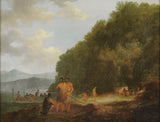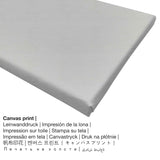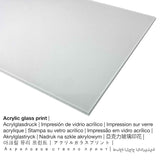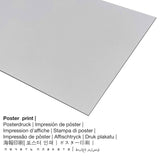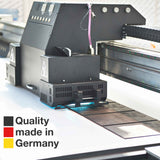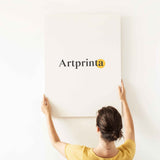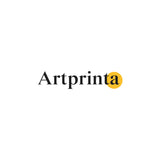John Webber, 1788 - Ship Cove, Queen Charlotte Sound - mbipụta nka mara mma
Ụtụ gụnyere. Mbupu gbakọrọ na ndenye ọpụpụ.
Họrọ nhọrọ akụrụngwa ngwaahịa
Na nhọrọ mwepu ngwaahịa ị nwere ike ịhọrọ nha na ihe onwunwe dabere na mmasị gị n'otu n'otu. Họrọ n'ime nhọrọ ngwaahịa ndị a ugbu a ka ị kwekọọ na mmasị gị na nha na akụrụngwa:
- Mpempe akwụkwọ ederede (akwa akwa akwa): Our poster is a UV printed flat canvas paper with a granular surface finish, that resembles the original masterpiece. It is optimally used for placing the art replica with the help of a special frame. Please bear in mind, that depending on the absolute size of the canvas poster print we add a white margin of around 2-6cm round about the work of art, which facilitates the framing with your custom frame.
- Mbipụta ọla (aluminium dibbond): These are metal prints on aluminium dibond material with an impressive effect of depth. The non-reflective surface structure creates a contemporary impression. For your Aluminium Dibond print, we print the selected artwork right onto the surface of the white-primed aluminum material. The white and bright sections of the original artwork shimmer with a silky gloss but without the glow. Colors are luminous in the highest definition, fine details of the print are crisp. This direct UV print on Aluminum Dibond is the most popular entry-level product and is an extremely sophisticated way to display fine art prints, because it puts the viewer’s attention on the replica of the artwork.
- Mbipụta iko acrylic (nke nwere ezigbo mkpuchi iko): An print on acrylic glass, often named a plexiglass print, will convert the original work of art into gorgeous home decoration. Moreover, the acrylic glass fine art print forms a great alternative option to dibond or canvas prints. The great benefit of an acrylic glass print is that contrasts plus minor artwork details will be identifiable due to the precise gradation in the print.
- Kwaaji: The canvas print is a printed cotton canvas mounted on a wooden stretcher. The canvas print generates a nice and pleasant impression. Your printed canvas of this artwork will let you turn your art print into a large artpiece. The great advantage of canvas prints is that they are relatively low in weight, meaning that it is easy and straightforward to hang up the Canvas print without the use of additional wall-mounts. Canvas prints are suited for all types of walls.
Nkwupụta iwu: We try everythig possible in order to depict our products as exact as possible and to illustrate them visually. Nevertheless, the pigments of the print materials and the printing can vary slightly from the presentation on the device's monitor. Depending on the settings of your screen and the quality of the surface, not all colors are printed as realistically as the digital version shown here. Because the are printed and processed by hand, there might as well be minor differences in the motif's exact position and the size.
Original artwork description by Museum of New Zealand - Te Papa Tongarewa website (© - site na Museum of New Zealand - Te Papa Tongarewa - Museum of New Zealand - Te Papa Tongarewa)
Ship Cove, Queen Charlotte Sound, circa 1788, England, by John Webber. Purchased 1991 from the Bishop Suter Art Gallery, Nelson, with New Zealand Lottery Grants Board funds; gift of Sir Francis Henry Dillon Bell to the Bishop Suter Art Gallery, 1931. Te Papa (1991-0005-1)
Eziokwu na-adọrọ mmasị banyere eserese na aha Ship Cove, Queen Charlotte Sound
a nka ochie nka nka aha Ship Cove, Queen Charlotte Sound onye na-ese ihe mere ya John Webber n’afọ 1788. Ihe gafere 230 year old original measures the size: sight: 762mm (width), 584mm (height) and was painted with the Usoro mmanụ na kwaaji. Today, this artpiece can be viewed in in the art collection of Museum of New Zealand - Te Papa Tongarewa, which is the national museum of New Zealand, with a great collection of artworks that contain deep ancestral links to the indigenous Māori population of New Zealand. We are happy to state that the work of art, which is part of the ngalaba ọha a na-enye ya site n'ikike nke Ship Cove, Queen Charlotte Sound, 1788, by John Webber. Purchased 1991 from the Bishop Suter Art Gallery, Nelson, with New Zealand Lottery Grants Board funds; gift of Sir Francis Henry Dillon Bell to the Bishop Suter Art Gallery, 1931. Te Papa (1991-0005-1). Moreover, the work of art has the creditline: Purchased 1991 from the Bishop Suter Art Gallery, Nelson, with New Zealand Lottery Grants Board funds; gift of Sir Francis Henry Dillon Bell to the Bishop Suter Art Gallery, 1931. In addition to this, the alignment of the digital reproduction is landscape and has a side ratio of 4 : 3, which implies that ogologo bụ 33% ogologo karịa obosara. John Webber was a male painter, printmaker from the United Kingdom, whose artistic style can primarily be attributed to Rococo. The Rococo artist lived for a total of 42 afọ - a mụrụ n'afọ 1751 in London, Greater London, England, United Kingdom and died in the year 1793 in London, Greater London, England, United Kingdom.
Nkọwa nka ahaziri
| Aha nka: | "Ship Cove, Queen Charlotte Sound" |
| Nhazi nka: | sere |
| Nhazi nka: | nka ochie |
| Century: | 18th narị afọ |
| Emepụtara n'afọ: | 1788 |
| Ogologo afọ nka nka: | karịa afọ 230 |
| Usoro nka izizi: | mmanụ na kwaaji |
| Nha izizi: | anya: 762mm (obosara), 584mm (ịdị elu) |
| Ụlọ ihe ngosi nka / mkpokọta: | Museum of New Zealand - Te Papa Tongarewa |
| Ebe ebe ngosi nka: | Te Aro, Wellington, New Zealand |
| Weebụsaịtị nke ihe ngosi nka: | Museum of New Zealand - Te Papa Tongarewa |
| Akwụkwọ ikike nka: | ngalaba ọha |
| Site n'aka: | Ship Cove, Queen Charlotte Sound, 1788, by John Webber. Purchased 1991 from the Bishop Suter Art Gallery, Nelson, with New Zealand Lottery Grants Board funds; gift of Sir Francis Henry Dillon Bell to the Bishop Suter Art Gallery, 1931. Te Papa (1991-0005-1) |
| kreditline ọrụ nka: | Purchased 1991 from the Bishop Suter Art Gallery, Nelson, with New Zealand Lottery Grants Board funds; gift of Sir Francis Henry Dillon Bell to the Bishop Suter Art Gallery, 1931 |
Nkọwa ihe ahaziri ahazi
| Nkewa edemede: | ezi nka mmeputakwa |
| Mmeputakwa: | mmeputakwa n'ụdị dijitalụ |
| Produzọ mmepụta: | UV kpọmkwem obibi |
| Mmalite nke ngwaahịa a: | arụpụtara na Germany |
| Ụdị ngwaahịa: | a na-achọ |
| Ihe eji eme atụmatụ: | nka mgbidi, mkpokọta nka (mmeputakwa) |
| Ntuziaka onyonyo: | nhazi odida obodo |
| Oke akụkụ: | 4:3- (ogologo: obosara) |
| Oke akụkụ pụtara: | ogologo bụ 33% ogologo karịa obosara |
| Nhọrọ akụrụngwa: | ígwè ebipụta (aluminium dibond), acrylic glass print (nwere ezigbo mkpuchi iko), mbipụta akwa akwa, mbipụta akwụkwọ mmado (akwụkwọ kwaaji) |
| Nhọrọ nha nha mbipụta kanvas (akwa akwa na etiti ihe ndọtị): | 40x30cm - 16x12", 80x60cm - 31x24", 120x90cm - 47x35", 160x120cm - 63x47" |
| Mbipụta iko acrylic (nke nwere ezigbo mkpuchi iko): | 40x30cm - 16x12", 80x60cm - 31x24", 120x90cm - 47x35", 160x120cm - 63x47" |
| Mpempe akwụkwọ mmado (akwụkwọ kwaaji) nha dị iche iche: | 40x30cm - 16x12", 80x60cm - 31x24", 120x90cm - 47x35" |
| Nha aluminom dibond (ihe aluminom) nha: | 40x30cm - 16x12", 80x60cm - 31x24", 120x90cm - 47x35" |
| Nhazi mbipụta nka: | agunyeghi |
Ose okwu
| aha: | John Webber |
| Aha utu aha: | Weeber, Webber, Webber John, Wäber Johann, Webber R.A., John Webber, Webber R. A. |
| okike onye nka: | nwoke |
| Obodo onye nka: | British |
| Ọrụ: | onye na-ebi akwụkwọ, onye na-ese ihe |
| Obodo onye nka: | United Kingdom |
| Nhazi nke onye nka: | nna ukwu ochie |
| styles: | Rococo |
| Oge ndu: | 42 afọ |
| Amụrụ n'afọ: | 1751 |
| Ebe amụrụ onye: | London, Greater London, England, United Kingdom |
| Afọ ọnwụ: | 1793 |
| Obodo ọnwụ: | London, Greater London, England, United Kingdom |
© nwebisiinka, Artprinta.com

